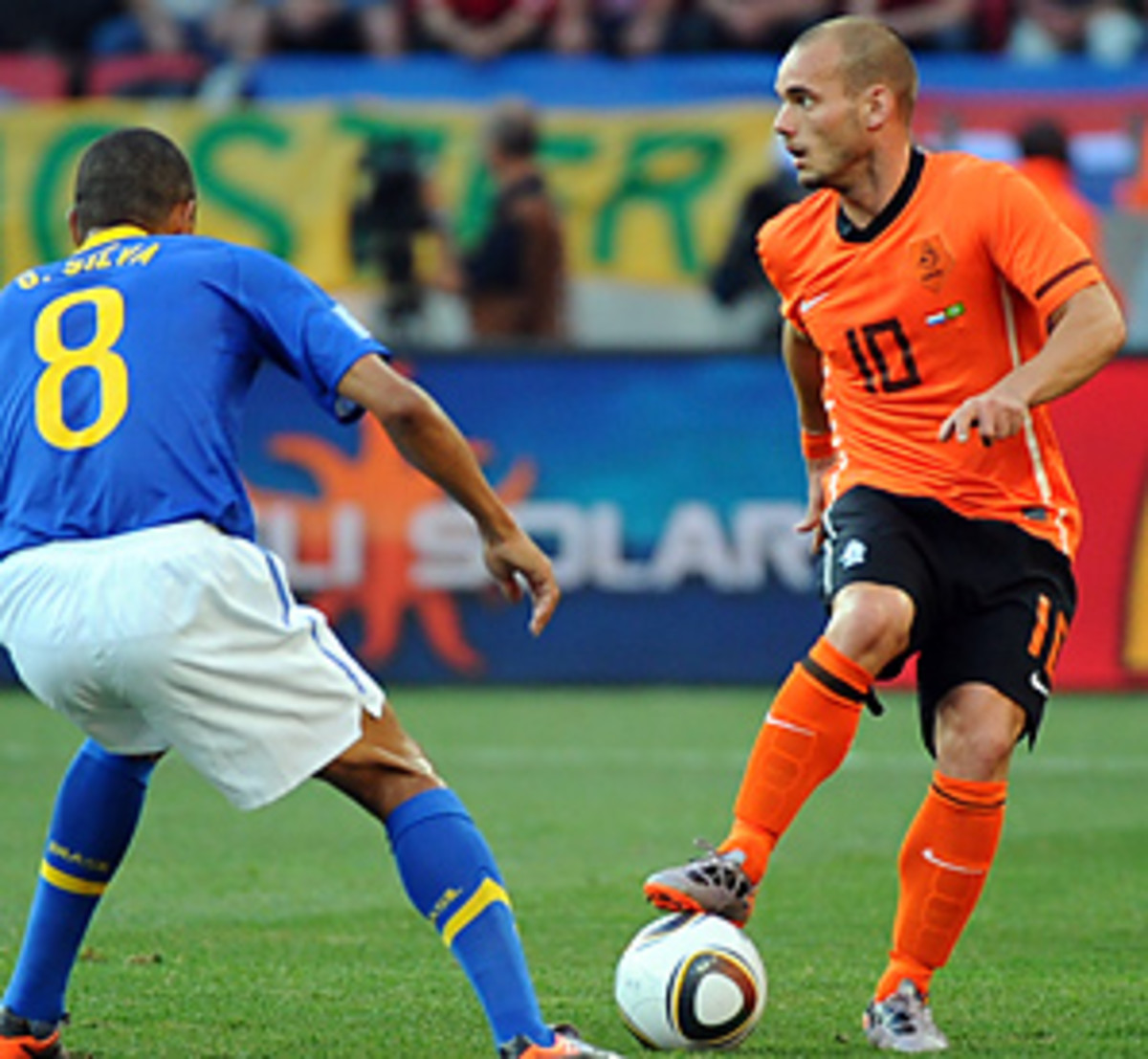
Criticism of a more defensive approach by the Dutch is misplaced
If you put this theory to the players themselves, they're mildly amused. Van Bommel (who plays for the German club Bayern Munich) agrees that this "Elftal" has more of a destructive, defensive capacity than its predecessors, and his partner in front of the back line, Nigel de Jong (who played for Hamburg before joining Manchester City in January 2009), has admitted to being influenced by the organizational emphasis of the Bundesliga. "We have learned that you have to keep a clean sheet, first of all," the 25-year-old de Jong said.
But this sense of realism should not be confused with a radical departure or even a betrayal of the grand Dutch tradition. It's always been there, to greater or lesser extent, over the course of the last 30 years. Mourning the demise of "Total Voetbal" these days makes as much sense as lamenting the switch from black and white to color television or the disappearance of horse carriages from city centers. The Dutch moved on decades ago. Most casual observers have simply been too lazy to notice it.
Total Football, as a tactical concept, was invented in the late 1960s/early 1970s by Johan Cruyff's Ajax Amsterdam. Its two big ideas were the maximum constriction of space for the opposition and the constant interchange between players in different positions. Fullbacks would become wingers, strikers midfielders, midfielders strikers at the drop of a hat. At a time when teams were tightly man-marking their opponents and worrying much less about space and shape, the free thinkers from "Clockwork Orange" were virtually unplayable.
By the time the Dutch reached their second World Cup final in a row in 1978, however, Total Football had given way to a much more orthodox system. It was still very attacking in outlook but had left the constant swapping of positions behind. As football was getting more athletic, playing such a work-intensive game became more difficult.
The 1988 team, which won the European championship, the country's first and only trophy, is best remembered for the individual brilliance of striker van Basten and deep-lying playmaker or shadow striker Ruud Gullit. But at the back the side also had the hard-as-nails Ronald Koeman, who effectively played as a sweeper. Mixing the sublime with brutish force at the back was key to its success.
The classic Dutch formation of 4-3-3 would largely stay unchanged throughout the decades, but football's trend toward highly specialized players continued to chip away at Total Football ideals. The Netherlands' 1994 World Cup team possessed brilliant players up front like striker Dennis Bergkamp, but it also had Jan (The Hoover) Wouters, a tough-tackling, nasty predecessor to Van Bommel in central midfield. The thought of those two swapping positions would have been totally absurd.
A heated debate before the start of Euro 2008 showed just how much Holland had already changed. Cruyff, still the chief football-ideologist of the nation in his own mind, harshly criticized Van Basten's 4-2-3-1 tactic. "Now we're playing like all the others," he said in a TV interview. "Holland must always play with three strikers and we don't need two [holding midfielders] in front of the defense. They only take away the space."
In the end, the Dutch played fantastically entertaining football in at that European championship, albeit with two defensive "controllers" in the center and a counterattacking strategy. Cruyff's nostalgic demands for a 40-year-old system fell on deaf ears as the Elftal found a formation and outlook that best suited its players. A perfect example was the substitution of holding midfielder Orlando Engelaar in favor of winger Arjen Robben in the 4-1 win over France in the group stage. Holland was leading 1-0 at the time and the swap was widely hailed as "typical Dutch" in the sense that it adhered to the principle of total attack. In fact, van Basten had simply readjusted his team: Official UEFA heat maps later showed that the midfield was collectively playing much deeper after the introduction of Robben.
"We gave ourselves space to go forward [on the counter] that way," Van Basten said. This was, in other words, not about simplistic labels like attack or defense, and certainly not about Cruyff's old concepts. "Those days have long gone," said Ruud van Nistelrooy, rolling his eyes, when English reporters confronted him with the Total Football tag after the game. The striker had actually been one of the main proponents for a second holding midfielder before the competition.
Claims that the Netherlands has now changed beyond recognition into a negative, cynical side are made only by those who wrongly bought into the opposite extreme of the Dutch as some sort of European Brazilians and eternal purveyors of the beautiful game before. In truth, they're no more defensive than 30 years ago; they've just found it very hard to break down opponents who have so far resisted from attacking them, unlike France and Italy in 2008.
"Beautiful football is difficult against teams who don't give you an inch of space," Wesley Sneijder said this week.
The fact that the Dutch have mostly grinded out victories does not reflect a diminished ambition or change of direction at all. It's merely been a function of coming up against deep-lying teams, difficult conditions (the heavy pitch in Port Elizabeth made it impossible for Robben to accelerate against Brazil in the quarterfinals) and not quite clicking up front.
There's every chance that all the obituary writers will quickly turn around to celebrate the resurrection of Total Football if a few well-executed attacking moves come off against limited Uruguay on Tuesday. Then we'll read that van Marwijk has given the team it's "true identity" back, and other nonsense. It's high time the old stereotypes were ditched, regardless of the result. Dutch soccer itself already did it a while back. Maybe the rest of the world should follow suit.




